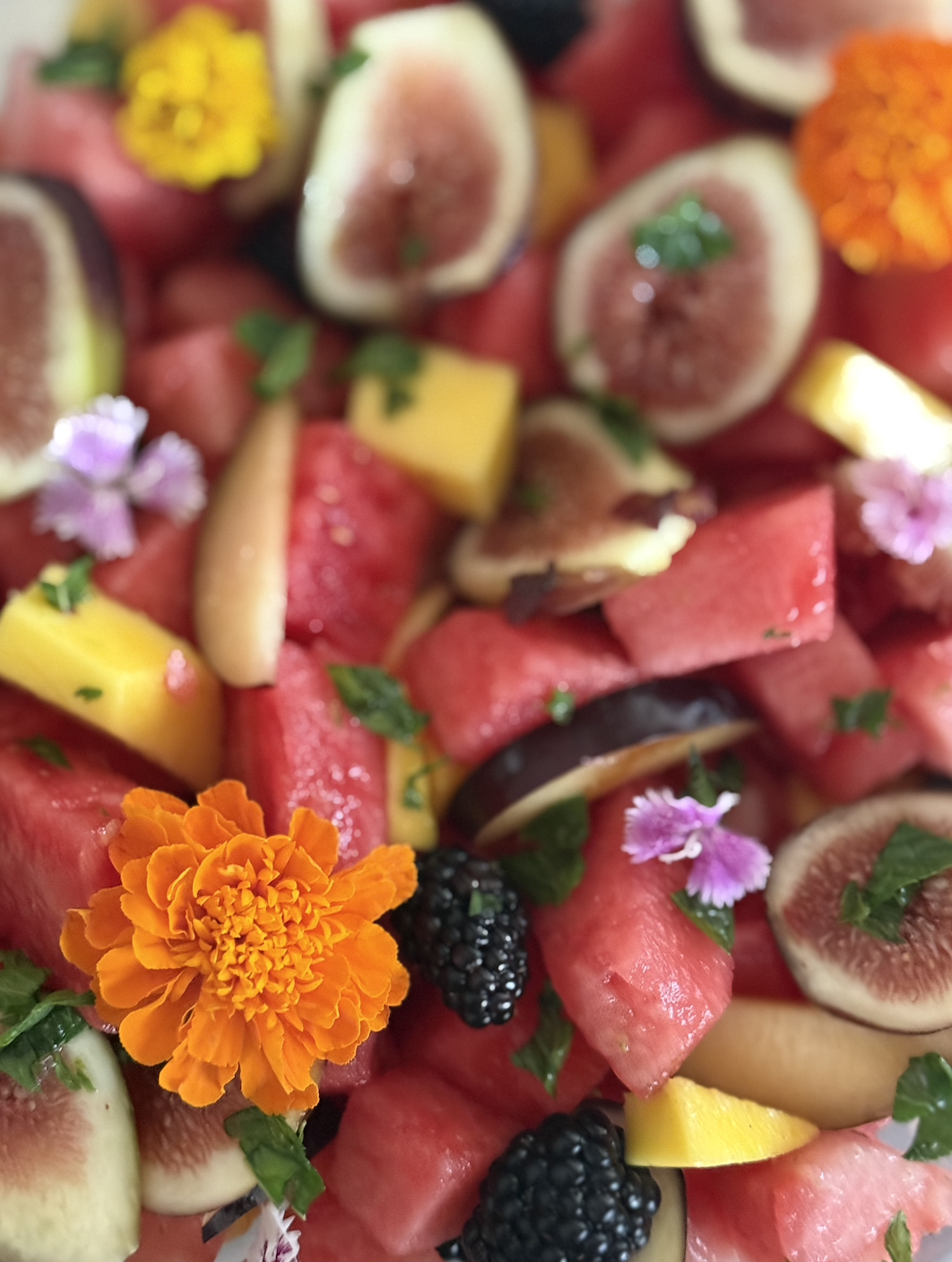Top 15 Anti-Inflammatory Foods and Why They Matter
By: Courtney G. Clifford
Inflammation is a natural process that helps the body heal and defend itself. But when inflammation becomes chronic, it can quietly contribute to conditions like arthritis, digestive issues, heart disease, and even low mood. One of the most powerful ways to calm inflammation is through what we put on our plates.
Modern nutritional science and ancient traditions like Ayurveda both highlight the healing power of foods. Ayurveda teaches us to balance the body through elements like warming spices, seasonal fruits, and grounding fats — many of which overlap with what research today confirms as anti-inflammatory. For the most part, I eat seasonal foods and try to source locally as much as possible. While I eat a variety of foods, I do try to keep the majority anti inflammatory. There is so much to consider when it comes to nutrition and it is highly personal, so I recommend speaking with a professional if you are seeking major changes.
Here is a list of the top 15 anti-inflammatory foods, with insights from both science and Ayurvedic wisdom.
1. Berries (Blueberries, Strawberries, Raspberries)
Rich in anthocyanins, powerful antioxidants that reduce oxidative stress and inflammation.
Studies show berries lower markers like CRP (C-reactive protein).
Ayurvedic note: Sweet and slightly astringent, berries balance excess heat (pitta) and support healthy digestion.
2. Fatty Fish (Salmon, Sardines, Mackerel)
High in omega-3 fatty acids (EPA & DHA), converted into compounds that actively reduce inflammation.
Linked to joint health and heart protection.
Ayurvedic note: Fish is grounding (kapha) and nourishing, though best in moderation for balance.
3. Turmeric
Contains curcumin, one of the most studied anti-inflammatory compounds.
Works by blocking NF-kB, a molecule that activates inflammation.
Ayurvedic note: A warming spice that reduces excess kapha and vata, often combined with black pepper for absorption.
4. Leafy Greens (Spinach, Kale, Swiss Chard)
Rich in vitamins A, C, and K, and polyphenols that protect cells.
Provide magnesium, which supports muscle relaxation and lowers stress-driven inflammation.
Ayurvedic note: Light, bitter greens help clear toxins (ama) and support liver balance.
5. Extra Virgin Olive Oil (cold pressed, high quality)
Contains oleocanthal, which has anti-inflammatory effects similar to ibuprofen.
Central to the Mediterranean diet, which lowers risk of chronic disease.
Ayurvedic note: Nourishing and unctuous, oil balances dryness (vata) and promotes longevity (ojas).
6. Ginger
Active compounds gingerols reduce muscle pain and joint stiffness.
Has both antioxidant and anti-inflammatory benefits.
Ayurvedic note: A warming digestive spice that stokes agni (digestive fire) and clears sluggishness.
7. Green Tea
Rich in EGCG, an antioxidant that reduces inflammatory cytokines.
Linked to lower risk of heart disease and neurodegeneration.
Ayurvedic note: Cooling and clarifying, green tea supports focus and reduces excess heat (pitta).
8. Nuts (Walnuts, Almonds, Pecans)
Provide healthy fats, magnesium, and antioxidants.
Walnuts especially contain plant-based omega-3s.
Ayurvedic note: Nuts are grounding, nourishing, and ojas-building, best soaked for easier digestion.
9. Avocados
Rich in monounsaturated fats and vitamin E.
Support joint and skin health while lowering inflammatory markers.
Ayurvedic note: Cooling and moisturizing, avocados help balance vata dryness.
10. Garlic
Contains allicin, which has immune-boosting and anti-inflammatory effects.
Supports cardiovascular and immune health.
Ayurvedic note: A pungent food that stimulates digestion and clears stagnation, though too much may aggravate heat.
11. Broccoli (+ Cruciferous Veggies)
Rich in sulforaphane, which lowers cytokine-driven inflammation.
Supports detoxification pathways.
Ayurvedic note: Light and slightly bitter, crucifers reduce ama (toxins) and balance kapha.
12. Chia Seeds & Flaxseeds
Excellent sources of fiber and plant-based omega-3s.
Support gut health and reduce inflammation via the microbiome.
Ayurvedic note: Moistening, grounding, and beneficial for vata imbalance when soaked.
13. Citrus Fruits (Oranges, Lemons, Grapefruit)
High in vitamin C, which reduces oxidative stress and supports immune balance.
Vitamin C also regulates cortisol, lowering stress-related inflammation.
Ayurvedic note: Sour and refreshing, citrus helps cleanse and energize, especially in spring.
14. Tomatoes
Rich in lycopene, especially when cooked.
Shown to reduce inflammatory markers in metabolic syndrome.
Ayurvedic note: Sweet and sour qualities balance dryness, though excess can aggravate acidity in pitta types.
15. Dark Chocolate (70%+)
Contains flavanols that improve circulation and lower inflammation.
Choose minimally processed chocolate with little sugar.
Ayurvedic note: A treat that can uplift mood and nourish, but best in moderation due to its stimulating effect.
A Sample Anti-Inflammatory Day of Eating
Breakfast
Warm turmeric oatmeal with chia seeds, blueberries, and walnuts
Green tea with ginger
Lunch
Quinoa salad with spinach, avocado, tomatoes, and olive oil-lemon dressing
Side of grilled salmon
Snack
Sliced oranges with a handful of almonds
Herbal ginger tea
Dinner
Garlic-roasted broccoli and sweet potatoes
Lentil soup with turmeric and cumin
Small square of dark chocolate for dessert
Conclusion
An anti-inflammatory diet is about more than individual foods; it’s about creating meals that nourish, balance, and protect. Both modern research and Ayurveda agree: nature already gives us the tools we need to calm inflammation and restore balance. By making these foods part of your daily rhythm, you’re building resilience from the inside out.
References
Calder, P. C. (2017). Omega-3 fatty acids and inflammatory processes: From molecules to man. Biochemical Society Transactions, 45(5), 1105–1115. https://doi.org/10.1042/BST20160474
Chong, M. F. F., Macdonald, R., & Lovegrove, J. A. (2010). Fruit polyphenols and CVD risk: A review of human intervention studies. British Journal of Nutrition, 104(Suppl. 3), S28–S39. https://doi.org/10.1017/S0007114510003900
Gupta, S. C., Patchva, S., & Aggarwal, B. B. (2013). Therapeutic roles of curcumin: Lessons learned from clinical trials. AAPS Journal, 15(1), 195–218. https://doi.org/10.1208/s12248-012-9432-8
Li, Y., Yao, J., Han, C., Yang, J., Chaudhry, M. T., Wang, S., … & Yin, Y. (2016). Quercetin, inflammation and immunity. Nutrients, 8(3), 167. https://doi.org/10.3390/nu8030167
Romagnolo, D. F., & Selmin, O. I. (2017). Mediterranean diet and prevention of chronic diseases. Nutrition Today, 52(5), 208–222. https://doi.org/10.1097/NT.0000000000000240

